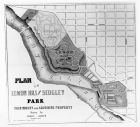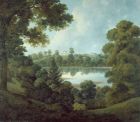Difference between revisions of "Lemon Hill"
Emily Pugh (talk | contribs) (→Images) |
Emily Pugh (talk | contribs) |
||
| Line 1: | Line 1: | ||
| + | "Lemon Hill (1800–01) is a Federal-style mansion in Fairmount Park, Philadelphia, built by the merchant Henry Pratt. Originally part of Robert Morris's 300-acre (120 ha) estate, The Hills, Pratt purchased 43 acres (17 ha) at a sheriff's sale for $14,654 in 1799. According to Pratt's letterbooks, recently discovered by Philadelphia Museum of Art assistant curator Martha C. Halpern, he designed the mansion himself and served as his own general contractor. Named for the many lemon trees in Morris's greenhouse, which was part of his new property, Pratt lived here until his death in 1838." | ||
| + | |||
http://en.wikipedia.org/wiki/Lemon_Hill | http://en.wikipedia.org/wiki/Lemon_Hill | ||
Revision as of 18:47, July 8, 2013
"Lemon Hill (1800–01) is a Federal-style mansion in Fairmount Park, Philadelphia, built by the merchant Henry Pratt. Originally part of Robert Morris's 300-acre (120 ha) estate, The Hills, Pratt purchased 43 acres (17 ha) at a sheriff's sale for $14,654 in 1799. According to Pratt's letterbooks, recently discovered by Philadelphia Museum of Art assistant curator Martha C. Halpern, he designed the mansion himself and served as his own general contractor. Named for the many lemon trees in Morris's greenhouse, which was part of his new property, Pratt lived here until his death in 1838."
http://en.wikipedia.org/wiki/Lemon_Hill
Alternate Names: The Hills
Site Dates:
Site Owner(s): Robert Morris (1734-1806), Henry Pratt (dates)
Site Designer(s):
Location:
Philadelphia, PA
View on Google maps
Associated Sites: Belmont (Pennsylvannia), Clermont, Fairmont
Associated Terms: Alley, Border, Conservatory, Gardenesque, Geometric style, Greenhouse, Grotto, Icehouse, Lake/Pond, Public garden/Public ground, Seat, Statue
Images
Frederick Graff, "Plan of Lemon Hill and Sedgley Park, Fairmount and Adjoining Property" (October 15, 1851); Fairmount Park; Library Company of Philadelphia, Philadelphia, PA
Bibliography
- Beebe, Lewis, 1800, describing Lemon Hill, estate of Henry Pratt, Philadelphia, Pa. (quoted in Martin 1991: 113)[1]
- "An ally of 13 feet wide runs the length of the garden thro' the centre—. Two others of 10 feet wide equally distant run parallel with the main alley. These are intersected at right angles, by 4 other alleys of 8 feet wide—Another alley of 5 feet wide goes around the whole garden, leaving a border of 3 feet wide next to the pales. This lays the garden into 20 squares, each square has a border around it of 3 feet wide. The border of the main alley, is ornamented with flowers of every description. Likewise the border of every square, is deco- rated with pinks and a thousand other flowers, which it [is] impossible for me to describe. The remaining part of each square, within the border, is planted with beans, pease, cabbage, onions, Beets, carrots, Parsnips, Lettuce, Radishes, Strawberries, cucumbers, Potatoes, and many other articles. . . . Within the pales, on the out border, one planted, Quince, snowball, Laylock, and various other small trees, producing the most beautiful flowers."
- Beebe, Lewis, 1800, describing Lemon Hill, estate of Henry Pratt, Philadelphia, Pa. (Historical Society of Pennsylvania, Journal of Beebe Lewis, 1799–1801, vol. 3)
- "Mr. Pratts garden for beauty and elegance exceeds all that I ever saw—The main alley, 13 feet wide, and 20 rods long is upon each side graced with flowers of every kind and colours—and 18 wide. An alley of 13 feet wide runs the length of the garden thro' the centre—Two others of 10 feet wide equally distant run parallel with the main alley. These are intersected at right angles by 4 other alleys of 8 feet wide—Another alley of 5 feet wide goes around the whole garden, leaving a border around it of 3 feet wide . . . next to the pales. . . . The border of the main alley is ornamented with flowers of every description."
- Committee of the Pennsylvania Horticultural Society, 1830, describing Lemon Hill, estate of Henry Pratt, Philadelphia, Pa. (quoted in Boyd 1929: 432)[2]
- "The treasures contained in the hot and green houses are numerous. Besides a very fine collection of Orange, Lemon, Lime, Citron, Shaddock, Berg- amot, Pomgranate and Fig trees in excellent condi- tion and full of fruit, we notice with admiration the many thousand of exotics to which Mr. Pratt is annually adding. The most conspicuous among these, are the tea tree; the coffee tree—loaded with fruit; the sugar cane; the pepper tree; Banana, Plan- tain, Guva, Cherimona, Ficus, Mango, the Cacti in great splendour, some 14 feet high, and a gigantic Euphorbia Trigonia—19 years old, and 13 feet high. The green houses are 220 feet long by 16 broad; exhibiting the finest range of glass for the preserva- tion of plants, on this continent. . . .
- "Mr. Pratt's are furnished with the rarest pro- ductions of every clime, so that the committee place the conservatory of Lemon Hill at the very head of all similar establishments in this country."
- Committee of the Pennsylvania Horticultural Society, 1830, describing Lemon Hill, estate of Henry Pratt, Philadelphia, Pa. (quoted in Boyd 1929: 432)[2]
- "The treasures contained in the hot and green houses are numerous. Besides a very fine collection of Orange, Lemon, Lime, Citron, Shaddock, Bergamot, Pomgranate and Fig trees in excellent condition and full of fruit, we notice with admiration the many thousand of exotics to which Mr. Pratt is annually adding. The most conspicuous among these, are the tea tree; the coffee tree—loaded with fruit; the sugar cane; the pepper tree; Banana, Plantain, Guva, Cherimona, Ficus, Mango, the Cacti in great splendour, some 14 feet high, and a gigantic Euphorbia Trigonia—19 years old, and 13 feet high. The green houses are 220 feet long by 16 broad; exhibiting the finest range of glass for the preserva- tion of plants, on this continent.
- "Colonel Perkins, near Boston, has it is true, a grapery and peach Espalier, protected by 330 feet of glass, yet as there are neither flues not foreign plants in them, they cannot properly be called green houses, whereas Mr. Pratt's are furnished with the rarest productions of every clime, so that the committee place the conservatory of Lemon Hill at the very head of all similar establishments in this country."
- Committee of the Pennsylvania Horticultural Society, 1830, describing Lemon Hill, estate of Henry Pratt, Philadelphia, Pa. (quoted in Boyd 1929: 432)[2]
- "In landscape gardening, water and wood are indispensable for picturesque effect; and here they are found distributed in just proportions with hill and lawn and buildings of architectural beauty, the whole scene is cheerfully animated by the brisk commerce of the river, and constant movement in the busy neighborhood of Fairmount."
- Committee of the Pennsylvania Horticultural Society, 1830, describing Lemon Hill, estate of Henry Pratt, Philadelphia, Pa. (quoted in Boyd 1929: 432)[2]
- "There are some pretty bowers, summer houses, grottos and fish ponds in this garden—the latter well stored with gold and silver fish."
- Downing, A. J., 1849, describing Lemon Hill, estate of Henry Pratt, Philadelphia, Pa. (p. 43)[3]
- "''Lemon Hill'', half a mile above the Fairmount water-works of Philadelphia, was, 20 years ago, the most perfect specimen of the geometric mode in America, and since its destruction by the extension of the city, a few years since, there is nothing comparable with it, in that style, among us. All the symmetry, uniformity, and high art of the old school, were displayed here in artificial plantations, formal gardens with trellises, grottoes, spring-houses, temples, statues, and vases, with numerous ponds of water, jets-d'eau, and other water-works, parterres and an extensive range of hothouses."
- Loudon, J. C. From Loudon, J. C. (John Claudius). 1850. An Encyclopaedia of Gardening; Comprising the Theory and Practice of Horticulture, Floriculture, Arboriculture, and Landscape-Gardening. 4th ed. London: Longman et al.: 331.
- 850. Lemon Hill, near Philadelphia. . . . [Downing observes:] '. . . An extensive range of hothouses, curious grottoes and spring-houses, as well as every other gardenesque structure, gave variety and interest to this celebrated spot, which we regret the rapidly extending trees, and the mania for improvement there, as in some of our other cities, have now nearly destroyed and obliterated.' (Downing's Landscape Gardening adapted to North America.)
- Wailes, Benjamin L. C., 29 December 1829, describing Lemon Hill, estate of Henry Pratt, Philadelphia, Pa. (quoted in Moore 1954: 359)[4]
- "But the most enchanting prospect is towards the grand pleasure grove & green house of a Mr. Prat[t], a gentleman of fortune, and to this we next proceeded by a circutous [sic] rout, passing in view of the fish ponds, bowers, rustic retreats, summer houses, fountains, grotto, &c., &c. . . . Next is a round fish pond with a small fountain playing in the pond. An Oval & several oblong fish ponds of larger size follow, & between the two last is an artificial cascade. Several summer houses in rustic style are made by nailing bark on the outside & thaching the roof. There is also a rustic seat built in the branches of a tree, & to which a flight of steps ascend. In one of the summer houses is a Spring with seats around it. The houses are all embelished [sic] with marble busts of Venus, Appollo, Diana and a Bacanti. One sits on an Island on the fish pond. All the ponds filled with handsome coloured fish." [See Fig. 1]
- Wailes, Benjamin L. C., 29 December 1829, describing Lemon Hill, estate of Henry Pratt, Philadelphia, Pa. (quoted in Moore 1954: 359–60)[4]
- "the hot house is said to be the largest in the US. It is filled to overflowing with the choicest Exotics: the Chaddock Orange of different kinds & the Lemon loaded with fruit. There are two coffee trees with their berries. Some few shrubs were in flower & others seeded, & I was politely furnished with a few seed of 2 varieties of flowers (Myrtle & an accacia). In front of the hot house, one at each end, is a Lion of marble, well executed, & a dog in front. On the roof is a range of marble busts."
- Watson, Joshua Rowley. From Foster, Kathleen A. 1997. Captain Watson's Travels in America: The Sketchbooks and Diary of Joshua Rowley Watson, 1772-1818. Philadelphia: University of Pennsylvania Press, 299.
- We drove over the Upper Bridge to Mr Pratts who has a large collection of plants and extensive Greenhouses & ca. His grounds are too much after the French manner of pleasure gardens.
Notes
- ↑ Martin, Peter. 1991. The Pleasure Gardens of Virginia: From Jamestown to Jefferson. Princeton, N.J.: Princeton University Press. View on Zotero
- ↑ 2.0 2.1 2.2 2.3 Boyd, James. 1929. A History of the Pennsylvania Horticultural Society, 1827–1927. Philadelphia: Pennsylvania Horticultural Society. View on Zotero
- ↑ Downing, A. J. [Andrew Jackson]. [1849] 1991. A Treatise on the Theory and Practice of Landscape Gardening, Adapted to North America; . . . Reprint of 4th edition. Washington, D.C.: Dumbarton Oaks Research Library and Collection. View on Zotero
- ↑ 4.0 4.1 Moore, John Hebron. 1954. "A View of Philadelphia in 1829: Selections from the Journal of B.L.C. Wailes of Natchez." Pennsylvania Magazine of History and Biography 78 (July): 353–60. View on Zotero



